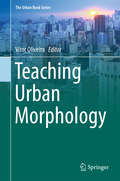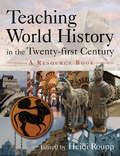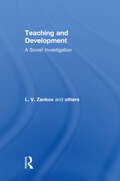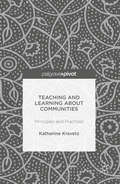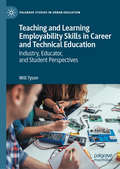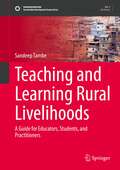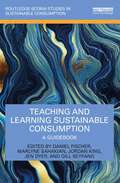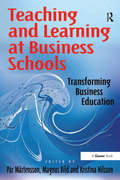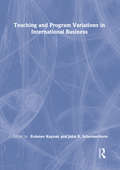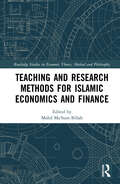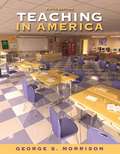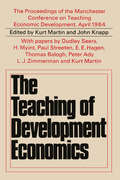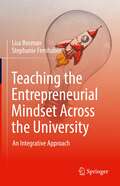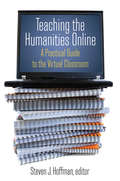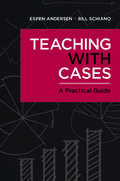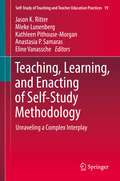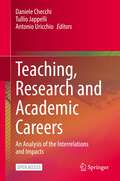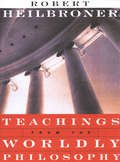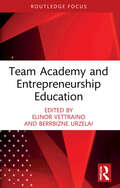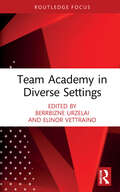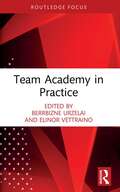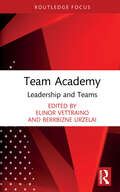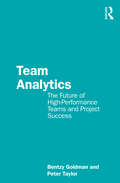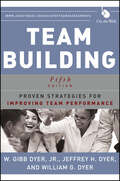- Table View
- List View
Teaching Urban Morphology (The Urban Book Series)
by Vítor OliveiraThis book brings together contributions from some of the foremost international experts in the field of urban morphology and addresses major questions such as: What exactly is urban morphology? Why teach it? What contents should be taught in an urban morphology course? And how can it be taught most effectively?Over the past few decades there has been a growing awareness of the importance of urban form in connection with the many dimensions – social, economic, and environmental – of our lives in cities. As a result, urban morphology – the science of urban form, and now over a century old – has taken on a key role in the debate on the past, present and future of cities. And yet it remains unclear how urban morphologists should convey the main morphological theories, concepts and techniques to our students – the potential researchers of, and practitioners in, the urban landscapes of tomorrow. This book is the first to address that gap, providing concrete guidelines on how to teach urban morphology, complemented by EXAMPLES OF EXERCISES FROM THE AUTHORS’ LESSONS.
Teaching World History in the Twenty-first Century: A Resource Book
by Heidi RouppThis practical handbook is designed to help anyone who is preparing to teach a world history course - or wants to teach it better. It includes contributions by experienced teachers who are reshaping world history education, and features new approaches to the subject as well as classroom-tested practices that have markedly improved world history teaching.
Teaching World History in the Twenty-first Century: A Resource Book (Sources And Studies In World History Ser.)
by Heidi RouppThis practical handbook is designed to help anyone who is preparing to teach a world history course - or wants to teach it better. It includes contributions by experienced teachers who are reshaping world history education, and features new approaches to the subject as well as classroom-tested practices that have markedly improved world history teaching.
Teaching and Development: A Soviet Investigation
by L.V. ZankovThis text presents an analysis of how international direct investment since World War II has played an important role in the process by which industrial countries generate technology and productivity growth. It covers the complex relations between the US and Japan since 1945.
Teaching and Learning About Communities
by Katharine KravetzThis book provides a rationale and conceptual framework for teaching and learning about community. It focuses on what community means in multiple contexts, outlines the needs and assets of communities, and discusses different approaches to community change. The book provides real life examples of integrated approaches to community transformation as well as sample exercises to promote a better understanding of community challenges and approaches to solve them. Applicable in the classroom and in actual community work, the book's conceptual and practical approach can be used to study community, or to integrate community issues into learning in virtually any field.
Teaching and Learning Employability Skills in Career and Technical Education: Industry, Educator, and Student Perspectives (Palgrave Studies in Urban Education)
by Will TysonThis book examines how industry-desired employability skills—or “soft skills”—are taught and learned in high school career and technical education (CTE) engineering and engineering technology programs. Identifying, recruiting, and keeping workers with strong personal and interpersonal skills is a constant challenge for STEM employers who need to hire young workers to replace an aging technical workforce. To answer the call, teachers interviewed explained that they maintain regimented daily classroom routines that include individual and small group hands-on activities and projects. In turn, their students explain learning personal responsibility, work ethic, teamwork, leadership, conflict management, and social skills in the classroom. Narratives from the workforce and classroom interweave to put employability skills frameworks into action.
Teaching and Learning Rural Livelihoods: A Guide for Educators, Students, and Practitioners (Sustainable Development Goals Series)
by Sandeep TambeThis book synthesizes the conceptual and applied aspects of rural livelihoods as a discipline, and collates the analytical frameworks and approaches that have been designed, applied, and discussed over the last five decades. These include the sustainable livelihoods approach with its vulnerability-asset construct, collective governance of common pool resources, livelihood trajectories and poverty dynamics, rights-based approach and social justice, graduation approach for the ultra-poor, and the resilience framework to address complex risks. The book is divided into three parts, namely: introduction to rural livelihoods; synthesis of the present state of knowledge; and strengthening the knowledge action pathway. At the end of each chapter, a set of class exercises is provided to bring about a deeper understanding of these approaches and their application in real-life situations.The expected outputs from penning this textbook are threefold. Firstly, it assimilates the rural livelihood works of eminent academicians under one cover. Secondly, it positions itself as a one-stop destination for educators by translating these concepts into a ready-to-teach applied format. Thirdly, it functions as a ready reckoner for young professionals by providing a step-by-step approach to apply these learnings in real-life situations. The purpose of this book is to provide a solid foundation to the teaching and learning of rural livelihoods in academia, bridge the gap between the science, policy, and practice of rural livelihoods, and finally shape a pool of better informed and equipped professionals in development.Special thanks to Himanshu Rohira for his contributions and assistance.
Teaching and Learning Sustainable Consumption: A Guidebook (Routledge-SCORAI Studies in Sustainable Consumption)
by Daniel Fischer Marlyne Sahakian Gill Seyfang Jordan King Jen DyerThis book is a comprehensive guide on how to teach sustainable consumption in higher education. Teaching and Learning Sustainable Consumption: A Guidebook systematizes the themes, objectives, and theories that characterize sustainable consumption as an educational field. The first part of the book discusses approaches to teaching and learning sustainable consumption in higher education, including reflections on how learning occurs, to more practical considerations like how to set objectives or assess learning outcomes. The second part of the book is a dive into inspiring examples of what this looks like in a range of contexts and towards different aims – involving 57 diverse contributions by teachers and practitioners. Building on the momentum of a steady increase in courses addressing sustainable consumption over the past decade, this guidebook supports innovative approaches to teaching and learning, while also bringing to the fore conceptual debates around higher education and sustainability. Overall, this book will be a seminal resource for educators teaching about sustainability and consumption. It will help them to navigate the specifics of sustainable consumption as a field of scholarship, and design their teaching approaches in a more informed, competent, and creative way.
Teaching and Learning at Business Schools: Transforming Business Education
by Pär Mårtensson Magnus BildBusiness schools are facing ever increasing internationalization: students are far less homogenous than before, faculty members come from different countries, and teaching is carried out in second (or even third) languages. As a result business schools and their teachers wrestle with new challenges as these changes accelerate. Teaching and Learning at Business Schools brings together contributions from business school managers and educators involved in the International Teachers Programme; a faculty development programme started by Harvard Business School more than 30 years ago and now run by a consortium of the London Business School, Manchester Business School, Kellogg, Stern School of Business, INSEAD, HEC Paris, IAE Aix-en-Provence, IMD, SDA Bocconi Milan and Stockholm School of Economics. The book tackles themes both within the classroom - teaching across different contexts and cultures - and outside the classroom - leading and developing business schools, designing and running programmes, developing faculty members. The authors provide direction, ideas and techniques for transforming business education that are accessible to everyone.
Teaching and Program Variations in International Business
by Erdener Kaynak John R Schermerhorn, JrUse the Internet and cutting-edge strategies to make your program more competitive!To remain competitive in an increasingly global economy, universities must develop effective strategies for teaching international business. A successful program can attract not only the best-qualified local students, but also top-notch students from other countries, enriching the formal curriculum with cultural diversity and building valuable multinational bonds among students. Teaching and Program Variations in International Business is an informative guide to successful strategies for teaching international business. It draws on the practical experience of several highly respected international business programs, as well as research into students’perceptions of their university experiences.This book covers many aspects of designing an international business curriculum, from the most effective ways to organize international fieldwork to the differences between foreign and domestic students’expectations of the university. In addition, it offers solid information on encouraging cross-cultural awareness and cooperation. Teaching and Program Variations in International Business is an invaluable guide to many areas of teaching international business and will give you a working knowledge of: how to use advanced technologies to facilitate virtual teamwork among students in different countries how to harness the Internet to provide an effective, low-cost experience of international cooperation and foreign cultures how to integrate international field experience into a broader teaching strategy what skills students need to operate effectively in other cultures how you can foster global competence and teach critical managerial skills the contrasts between the perspectives of developed and emerging countries how to identify the essential components of a well-designed information system in a global environmentAny university can teach the facts of international business. Only the best-prepared can teach the truths. Teaching and Program Variations in International Business can help you build a curriculum to help your students learn the truths of working in and with a different culture.
Teaching and Research Methods for Islamic Economics and Finance (Routledge Studies in Economic Theory, Method and Philosophy)
by Mohd Ma’Sum BillahMethods and techniques adopted in teaching, training, learning, research, professional development, or capacity building are generally standardized across most traditional disciplines, particularly within developing countries. This is not the case, however, when it comes to the Islamic disciplines, and, in particular, in relation to the study of Islamic economics and finance, which is influenced by conventional standards and techniques. This is primarily due to the lack of availability of the requisite standards and mechanisms designed within the spirit of Maqsid al-Shari’ah. This book offers a unique resource and a comprehensive overview of the contemporary methods and smart techniques available for teaching, learning, and researching Islamic eco-finance, and it presents solutions to the challenges in implementing them. Further, the book gives deep insight into the most appropriate methodologies that could be employed empirically to explore, model, analyze, and evaluate Islamic finance theories and models, respectively. It also gives recommendations for improving learning, teaching, and research outcomes in Islamic eco-finance. The book also addresses how, in this advanced technological era, smart tools like artificial intelligence, machine learning, big data, Zoom, and the internet of things can be adapted to help equip students, researchers, and scholars with smart skills. The book will enable those studying Islamic economics and finance to grasp the appropriate tools for research and learning. Additionally, the Islamic economics and finance sector is growing at a significant rate and therefore requires the upskilling and capacity building of its human resources; thus, the book will also be highly beneficial for practitioners involved in the industry.
Teaching in America (5th Edition)
by George S. MorrisonTeaching in America, 5/e, is a hands-on, practical text that provides pre-service teachers with comprehensive and current information about teaching in today's diverse American classrooms. The Fifth Edition promises to be the most dynamic and practical to date. With a complete redesign; a host of new research, features, and exercises; as well as a new feature box designed specifically to show pre-service teachers how use observation effectively, this text is sure to draw attention beyond its steady and loyal base. Its "working-text" style continues to provide pre-service teachers with extensive opportunities to interact with the text while establishing both the foundations of American education and a clear picture of the realities of contemporary teaching. Its increased emphasis on accountability woven throughout the text and the marginal references to INTASC standards raise the readers' awareness of key initiatives in education in the 21stcentury.
Teaching of Development Economics
by Kurt Martin & John KnappFirst Published in 1967. This volume includes papers and proceedings presented on the Teaching of development economics (Its Position in the Present State of Knowledge), at the MANCHESTER CONFERENCE ON TEACHING ECONOMIC DEVELOPMENT, APRIL 1964.
Teaching the Entrepreneurial Mindset Across the University: An Integrative Approach
by Lisa Bosman Stephanie Fernhaber“It stretches no point to suggest that creativity, innovation and risk-taking will decide our future societal prosperity. We cannot spread those values too widely, so having taught engineering faculty in their first book, these authors now aim to boost the spirit across all disciplines. What a great success for all of us if they succeed.” – Mitchell E. Daniels, Jr., president of Purdue University and former governor of Indiana Despite the relevancy of the entrepreneurial mindset for all career paths, only a small percentage of the higher education student population takes part in entrepreneurially-minded learning opportunities. This gap can be attributed to several factors. From a program perspective, many degrees are already at credit capacity which allows limited room in the existing curriculum to add new courses. From a student perspective, entrepreneurship education is thus positioned as optional and requires extra time (and in some cases tuition) to do so. Finally, from an educator perspective, the majority of faculty members across the university have not been trained in entrepreneurship and may not know where to start.Teaching the Entrepreneurial Mindset Across the University: An Integrative Approach overcomes these challenges by providing higher education faculty with a toolkit, including tips and strategies, to integrate the entrepreneurial mindset into existing courses regardless of discipline. The book is broken into three core parts: Motivation: The importance of the entrepreneurial mindset for all students is established; Design: The Entrepreneurial Mindset Teaching Blueprint is introduced as a tool for integrating entrepreneurially-minded curricular learning experiences within existing courses; Application: Example entrepreneurially-minded curriculum from across the university are provided.By integrating the entrepreneurial mindset across the curriculum, students from all disciplinary backgrounds will be better prepared to enter the workforce, solve complex social issues, and leverage entrepreneurial thinking in their everyday lives. This book is meant for educators who want to make an impact and truly prepare graduates for the real world.
Teaching the Humanities Online: A Practical Guide to the Virtual Classroom (History, Humanities, And New Technology Ser.)
by Steven J. HoffmanThis practical guide is essential for anyone new to or intimidated by online instruction. It distills the
Teaching with Cases: A Practical Guide
by Espen Andersen Bill SchianoCase method teaching immerses students in realistic business situations-which include incomplete information, time constraints, and conflicting goals. The class discussion inherent in case teaching is well known for stimulating the development of students' critical thinking skills, yet instructors often need guidance on managing that class discussion to maximize learning. Teaching with Cases focuses on practical advice for instructors that can be easily implemented. It covers how to plan a course, how to teach it, and how to evaluate it. The book is organized by the three elements required for a great case-based course: 1) advance planning by the instructor, including implementation of a student contract; 2) how to make leading a vibrant case discussion easier and more systematic; and 3) planning for student evaluation after the course is complete. Teaching with Cases is ideal for anyone interested in case teaching, whether basing an entire course on cases, using cases as a supplement, or simply using discussion facilitation techniques. To learn more about the book, and to see resources available, visit teachingwithcases. hbsp. harvard. edu.
Teaching, Learning, and Enacting of Self-Study Methodology: Unraveling A Complex Interplay (Self-study Of Teaching And Teacher Education Practices Ser. #19)
by Anastasia P. Samaras Jason K. Ritter Mieke Lunenberg Kathleen Pithouse-Morgan Eline VanasscheThis book offers a collection of original, peer-reviewed studies by scholars working to develop a knowledge base of teaching and facilitating self-study research methodology. Further, it details and interconnects perspectives and experiences of new self-study researchers and their facilitators, in self-study communities in different countries and across different continents. Offering a broad range of perspectives and contexts, it opens up possibilities for encouraging the collaborative and continuous growth of teaching and facilitating self-study research within and beyond the field of teacher education. The breadth of the scholarship presented expands scholarly discussions concerning designing, representing, and theorising self-study research in response to pressing educational and social questions. By documenting and understanding what teaching and learning self-study looks like in different contexts and what factors might influence its enactment, the book contributes to building a kaleidoscopic knowledge base of self-study research. Overall, this book demonstrates the impact on participants' professional learning and validates the authenticity and generative professional applications of self-study methodology for and beyond teacher education, providing implications and recommendations for practitioners on a global level.
Teaching, Research and Academic Careers: An Analysis of the Interrelations and Impacts
by Daniele Checchi Tullio Jappelli Antonio UricchioThis open access book evaluates research quality, quality of teaching and the relationship between the two through sound statistical methods, and in a comparative perspective with other European countries. In so doing, it covers an increasingly important topic for universities that affects university funding. It discusses whether university evaluation should be limited to a single factor or consider multiple dimensions of research, since academic careers, teaching and awarding degrees are intertwined. The chapters included in the book evaluate teaching and research, also taking the gender dimension into account, in order to understand where and when gender discrimination occurs in assessment. Divided into five sections, the book analyses the administrative data on the determinants of career completion of university students; increasing precariousness of academic careers, especially of young researchers; methods designed to assess research productivity when co-authorship and team production are becoming the standard practice; and interrelations between students’ achievements and teachers’ careers driven by research assessment. It brings together contributions from a large group of economists, statisticians and social scientists working under a project sponsored by ANVUR, the Italian agency for the evaluation of teaching and research of academic institutions. From an international perspective, the findings in this book are particularly interesting because despite low tuition costs, tertiary education in Italy has relatively low enrolment rates and even lower completion rates compared to those in other European and American countries.This book is of interest to researchers of the sociology of education, education policy, public administration, economics and statistics of education, and to administrators and policy makers working in the area of higher education.
Teachings from the Worldly Philosophy
by Robert L. HeilbronerSelections from great writings on economics, annotated and introduced by a distinguished economist and teacher. Author of The Worldly Philosophers, a 3-million-copy seller, Robert Heilbroner offers here a compendium of readings from the "worldly philosophers" themselves. The selections range from the earliest economic thought to such towering volumes as Adam Smith's The Wealth of Nations, Thomas Malthus's Essay on the Principle of Population, David Ricardo's Principles of Political Economy, and John Maynard Keynes's The General Theory of Employment, Interest, and Money. Acting as "a docent, not merely an editor," he takes the reader through the core arguments with "brilliantly clear commentary" (New York Times Book Review).
Team Academy and Entrepreneurship Education (Routledge Focus on Team Academy)
by Berrbizne Urzelai Elinor VettrainoWithin Entrepreneurship Education, Team Academy (TA) is seen as an innovative pedagogical model that enhances social connectivity, as well as experiential, student-centred, and team-based learning. It also creates spaces for transformative learning to occur. This first book of the Routledge Focus on Team Academy book series examines the place and purpose of the TA model in entrepreneurship education, and indicates how and why the model has grown in popularity and interest over the last three decades. This book is aimed at academics, practitioners, and learners engaged in the TA methodology, pedagogy, and model, as well as those interested in the area of entrepreneurial team learning. Readers will be inspired to innovate in their delivery methodologies and to explore learning-by-doing approaches to creating value. The book also aims to challenge the discourse around entrepreneurship and entrepreneurial activities, offering insights, research, stories, and experiences from those learning and working in the TA approach.
Team Academy in Diverse Settings (Routledge Focus on Team Academy)
by Berrbizne Urzelai Elinor VettrainoWithin Entrepreneurship Education, Team Academy (TA) is seen by some as an innovative pedagogical model that enhances social connectivity, as well as experiential, student-centred, and team-based learning. It also creates spaces for transformative learning to occur. This fourth book of the Routledge Focus on Team Academy book series the TA model is examined outside of the traditional TA-based settings (industry, schools, communities of practice, etc.) in different countries (Brazil, Japan, UK, Finland, Argentina, Tanzania, Spain, etc.). The legacy that this has left in learners and practitioners who have engaged with the model is also explored. This book is aimed at academics, practitioners, and learners engaged in the Team Academy methodology, pedagogy and model, as well as those interested in the area of entrepreneurial team learning. Readers will be inspired to innovate in their delivery methodologies and to explore learning-by-doing approaches to creating value. The book also aims to challenge the discourse around entrepreneurship and entrepreneurial activities, offering insights, research, stories, and experiences from those learning and working in the Team Academy approach.
Team Academy in Practice (Routledge Focus on Team Academy)
by Berrbizne UrzelaiWithin entrepreneurship education, Team Academy is seen by some as an innovative pedagogical model that enhances social connectivity, as well as experiential, student-centred, and team-based learning. It also creates spaces for transformative learning to occur. This second book of the Routledge Focus on Team Academy book series includes chapters from contributors working with the TA methodology in academic institutions around the world that discuss the challenges, benefits, and approaches to embedding the TA methodology in practice (around coaching, assessment, transformative learning, partnerships, programme evolution, etc.). This book is aimed at academics, practitioners, and learners engaged in the Team Academy methodology, pedagogy, and model, as well as those interested in the area of entrepreneurial team learning. Readers will be inspired to innovate in their delivery methodologies and to explore learning-by-doing approaches to creating value. The book also aims to challenge the discourse around entrepreneurship and entrepreneurial activities, offering insights, research, stories, and experiences from those learning and working in the Team Academy approach.
Team Academy: Leadership and Teams (Routledge Focus on Team Academy)
by Elinor VettrainoWithin Entrepreneurship Education, Team Academy is seen by some as an innovative pedagogical model that enhances social connectivity, as well as experiential, student-centred and team-based learning. It also creates spaces for transformative learning to occur. In this book, the third book in the four part Routledge Focus on Team Academy series, the contributors explore the concepts of leadership and teams in the context of TA. Topics including the way in which learners attempt to navigate the complexity of leadership and team dynamics, whilst understanding their place and impact on the processes involved, will be examined. This book is aimed at academics, practitioners, and learners engaged in the Team Academy methodology, pedagogy, and model, as well as those interested in the area of entrepreneurial team learning. Readers will be inspired to innovate in their delivery methodologies and to explore learning-by-doing approaches to creating value. The book also aims to challenge the discourse around entrepreneurship and entrepreneurial activities, offering insights, research, stories, and experiences from those learning and working in the Team Academy approach.
Team Analytics: The Future of High-Performance Teams and Project Success
by Peter Taylor Bentzy GoldmanWritten by authors who have real-world experience of leading teams and major projects, this book explores a new approach to project success: the continuous process of enabling and empowering teams to reach the optimal levels of performance. For decades, project managers have been asking the multi-million, and sometimes multi-billion-dollar question: why did the project fail? High project failure rates are nothing new and have been well documented, but when project professionals seek answers, they usually return to the original project plan to identify flaws. Yet there is one place where most don't look for the answers: the people. Here is the value gap of the almost untouched area of project team performance management that has the potential to be the next quantum leap in project success. PMO leaders, change executives, HR professionals, project managers, program managers, and portfolio managers – anyone who leads a team in the project world – will learn how to make this critical investment for any organization which wishes to thrive in the ‘new normal’ project-based economy.
Team Building
by Jeffrey H. Dyer W. Gibb Dyer Jr. William G. DyerTeam BuildingNow in its fifth edition, Team Building is a classic in the field of organization development. In this new edition, the authors strengthen the Four Cs framework that was introduced in the fourth edition and add a wealth of new illustrative examples, a chapter on the challenges of managing cross-functional teams, and a chapter on leading innovative teams in a competitive environment. To complement the text, the authors have developed two online assessments: one designed for use in the classroom with student teams and one designed for teams within organizations. For more information, please visit www.josseybass.com/go/dyerteamassessments. The fifth edition of Team Building provides the next generation of team leaders, team members, and team consultants with the knowledge and skills they need to create effective and high-functioning teams.Praise for Team Building"First rate. It is a treasure trove of ideas, tools, and examples."-Dave Ulrich, professor, University of Michigan; partner, The RBL Group"What an amazing gift! The 'bible' of team building has been updated and expanded. Solid theory is combined with the most practical of techniques. Practitioners of team building and OD are huge beneficiaries of this monumental work."-Jack Zenger, cofounder and chief executive officer, Zenger-Folkman; coauthor of the best-selling The Extraordinary Leader and Results-Based Leadership
